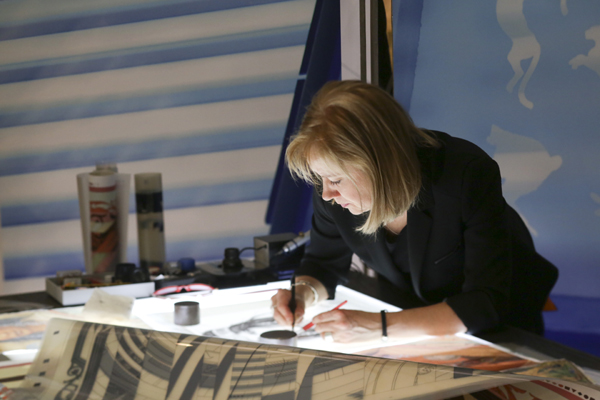Seeking deliberation in a scarf
|
Nadine Rabilloud is known as a "silk engraver". Provided to China Daily |
The slogan "today, you are in - and tomorrow, you are out" perfectly describes the fast pace of the fashion industry. However, some luxury labels have seen the importance of time-intensive handicraft art, trying to preserve and popularize it.
French luxury house Hermes opened Festival des Metiers last week in Beijing's World Trade Center Shopping Mall, bringing eight artisans to China to show their traditional skills.
France's Nadine Rabilloud is one of the team. She is a "silk engraver" - a job that is difficult to comprehend these days.
When people think of the process of making a silk scarf, they will naturally think of a machine that can print all the details of the pattern on the scarf, and can quickly stamp out a lot of them in a short time.
However, Rabilloud's job is totally different. She must create many different stencils, pieces of plastic that have different designs cut out in them.
These are used to paint on a surface of the scarf, so that paint goes through the holes and leaves a design on the scarf's surface.
"It is more like Chinese engraving paintings," Robilloud says. She has to spend at least 600 hours to make a multitude of stencils for a single scarf. At the same time, she has to be very sensitive to the slight differences between colors, as each scarf contains more than 30 hues.
Other craftsmen include Vincent Leopold, known for his skills in making, repairing saddles and other equipment for riding horses, as well as leather craftsman Alexandre Lay, shirt maker Nadia Chabane, and tie-maker Manon Fantauzzi.
Hermes is not the first to promote such traditional skills. Early in 2010, Prada launched its "Made In" series.
The series was inspired by the handicrafts in different parts of the world. For example, Prada's Made in Scotland has a lot of tartans, which have been a icon of the country since the fourth century.
The label's collection of tartan kilts are produced with wool from workshops in the United Kingdom, all of which have centuries-old manufacturing and weaving techniques.
The fashion industry is often considered superficial and soulless, and that is why some industry leaders have started to reflect on how to make it more meaningful, rather than just producing a lot of garments.
Promoting hand-crafted pieces is a good way. As Florian Craen, managing director of Hermes North Asia, says: "This mission combines respect for tradition with enthusiasm for the future, and over the course of six generations, Hermes' master craftsmen have brought this defining spirit to life."
Some sophisticated fashionistas in China - with a bit of cash to spare - are choosing garments that are not mass-produced in big factories. They want to wear something unique. These garments feature traditional skills and heartfelt design. They also promise good quality.
gantian@chinadaily.com.cn

























